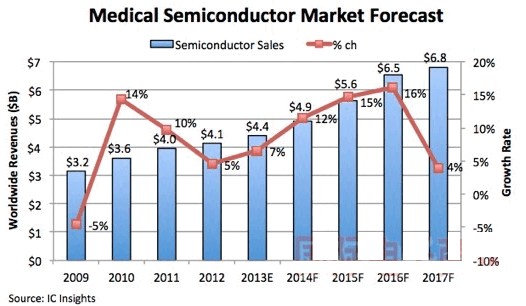According to the latest report from market research firm IC Insights, after experiencing the slow growth of the global economy since 2010 and the cost of controlling medical costs in the US and Europe, medical electronics will resume strong growth in the next three years. The report predicts that medical electronics sales will continue to grow by 8% in 2014, reaching $50.9 billion. Sales of semiconductors for medical systems increased to $4.9 billion in 2014, with a growth rate of 12%.
From 2012 to 2017, global medical electronics sales are expected to grow to $65.4 billion at a compound annual growth rate (CAGR) of 7.3%. Sales of semiconductors for medical device systems will grow at a compound annual growth rate of 10.5% to $6.8 billion.

Medical semiconductor market forecast
In the next few years, the medical electronics market will grow strongly, thanks to the popularity of low-cost diagnostic and imaging equipment in China and other developing countries, and the promotion of wireless mobile medical systems for remote monitoring of patients and reduced hospitalization costs. In 2014, revenues for wireless mobile healthcare systems and wearable fitness tracking devices are expected to jump 53% from $1.2 billion this year to nearly $1.9 billion, while global sales will grow 27%.
In response to the low cost and increasing practicality of medical equipment in response to poverty and developing countries, equipment manufacturers present two different trends in medical systems for hospitals, clinics, and doctors' offices. One of the trends is to create smaller, cheaper medical diagnostic systems for hospital wards, clinics, and doctors' offices than hospitals' examination rooms and imaging centers. Advanced sensors (based on microelectromechanical systems (MEMS) technology), wireless ICs, and chip system (SoC) designs create new mobile medical devices that monitor patients and the elderly at home and then transmit information over the wireless connection of a mobile phone or the Internet To a doctor or hospital.
Another trend is to create a more powerful integrated system that, although expensive, can reduce costs in some ways, such as detecting cancer and disease early, while supporting minimally invasive surgery to quickly recover and reduce hospital stays. New technologies such as computer-assisted surgery systems, surgical robots, and operating room automation have been adopted by hospitals in some developed countries.
Although developed countries (such as the United States, Europe, and Japan) account for only 18% of the world's population, in 2012 these countries' medical expenses totaled $5.3 billion, accounting for 80% of the world, compared with 178 other developing countries. Medical expenses in poor countries are only $1.4 billion. The aging population in both developed and developing countries will benefit greatly from the new wireless health monitoring system and telemedicine services designed to reduce costs and serve more patients. Although medical equipment has been weakly sold in large mature markets in recent years, it has been booming in China thanks to its plans to significantly increase primary health care, hospitals, medical infrastructure and medical service windows in rural areas. During this decade, China’s investment in healthcare infrastructure will reach $63.5 billion. Therefore, in the next four years, China's share of global medical equipment sales will more than triple, reaching 10% by 2017. In comparison, this figure was only 3% in 2013. At the same time, the market share of developed countries will shrink.
Shampoo Unit,Salon Backwash Unit,Shampoo Backwash Unit,Salon Shampoo Backwash Units
TOM SPA BEAUTY SALON EQUIPMENT CO.,LTD , https://www.tomspabeauty.com